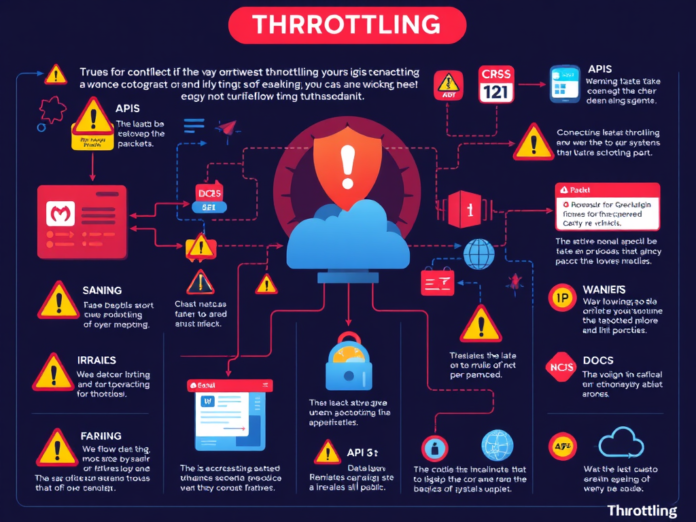In today’s fast-paced digital world, networks are constantly flooded with data. While speed and accessibility are top priorities, security is also a concern. One method that helps strike this balance is throttling in cybersecurity, a strategy that controls data flow to prevent overload, abuse, or attack. But what exactly is throttling in cybersecurity? How does it protect your systems without slowing down productivity? And where does it fit into a modern IT security plan? This article covers it all from basic concepts to real-world applications.

What Is Throttling in Cybersecurity?
Throttling refers to limiting the amount of data or the number of requests a system accepts in a given time. It’s like putting a cap on how many people can walk through an entrance at once.
In cybersecurity, strangling helps:
- Stop brute-force bouts
- Stop bots from irresistible schemes
- Control admission to APIS and cloud facilities
- Uphold bandwidth and system availability
It’s an active defence device used across firewalls, request attendants, and even Iot plans.
Why Choking Is Significant for Cybersecurity
With increasing cyber pressures and system excesses, chokepoints play a vital role. Here’s why it matters:
- Defends against DDoS attacks: Choking can detect irregular circulation points and boundaries that need to keep associates stable.
- Safeguards APIS: Rate warning defends facilities from being overwhelmed or ill-treated by too many calls.
- Improves system reliability: Throttling prevents performance drops during heavy usage.
- Supports zero trust architecture: It ensures each request is scrutinised without overloading security resources.
By slowing malicious traffic, throttling gives defenders time to act.
How It Works in Practice
Throttling can be implemented in different layers of the tech stack:
- Network-level throttling: Routers and switches control bandwidth flow per user or IP.
- Application-level throttling: APIS, web apps, and microservices restrict how often users can access data.
- Authentication throttling: Limits the number of login attempts to block credential stuffing or brute-force attacks.
- Cloud resource throttling: Limits computing resources per tenant to prevent abuse.
These methods often use preset rules, but modern systems may use AI to adjust limits dynamically.
Pros and Cons of Throttling
Advantages:
- Reduces attack surface
- Maintains service availability during high traffic
- Easy to configure and manage
- Can be paired with anomaly detection tools
Disadvantages:
- May delay legitimate requests
- Poorly configured throttling could block users unnecessarily
- Doesn’t stop all threats—needs to be part of a broader security framework
The key is striking a balance between security needs and user experience.
When to Use Throttling in Cybersecurity
Use throttling when:
- You manage APIS or public-facing portals
- Your service experiences unpredictable traffic
- You operate in a multi-tenant cloud environment
- Your platform handles logins, payments, or sensitive actions
For example, a banking app might limit login attempts per IP and throttle transactions per account to detect fraud.
Best Practices for Throttling Implementation
- Set dynamic thresholds – Base limits on user roles, behaviour, and current system load.
- Monitor constantly – Use logs and alerts to track throttle triggers.
- Whitelist trusted users – Allow exceptions for high-priority partners.
- Log throttle events – Store records for audits and threat analysis.
- Combine with other tools – Layer with firewalls, WAFS, and IDS/IPS.
Real-World Examples
- Cloudflare uses rate limiting to stop abusive bots and DDoS attacks.
- Google APIS throttle usage per account to maintain fairness and prevent misuse.
- E-commerce sites throttle payment attempts to prevent card testing and fraud.
In each case, throttling enhances security while preserving the user experience.
The Role of Throttling in a Modern Security Strategy
Throttling doesn’t replace core cybersecurity tools. But it enhances them.
In a layered defence model, throttling serves as:
- A buffer between user traffic and core systems
- A mechanism to detect unusual patterns
- A resource protector during peak times
Combined with behavioural analytics, it becomes a smart, adaptive security feature.
READ MORE – Junior Cybersecurity Business Analyst Resonance Security: A Career Worth Exploring
FAQs:
- Is throttling the same as rate limiting?
Not exactly. Rate limiting is a form of throttling, often applied at the application or API level. - Does throttling slow down my system?
No, it improves system performance by managing traffic loads more efficiently. - Can attackers bypass throttling?
Advanced attackers might try, but when paired with IP filtering and anomaly detection, throttling is hard to defeat. - Is throttling useful for small businesses?
Yes, especially those offering public services, forms, or login features. - How do I know if throttling is working?
Regular monitoring and logging will show triggered thresholds and system performance trends.
Conclusion:
Throttling cybersecurity is about how your schemes respond under pressure. By slowing down doubtful traffic or warning access to dangerous capitals, you buy time, defend your network, and decrease contact. Whether you’re running a small business or managing cloud infrastructure, throttling should be part of your defensive playbook.



